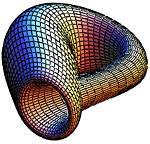

Research Projects
|
|
|
|
|
|
|
|
|
|
My research program blends theoretical and applied aspects of intelligent systems. Knowledge transfer to academia, students, and industrial partners originates from both the core and application research programs. My core research program focuses on fundamental issues underlying the design of intelligent systems. Some of the focus areas include:
- Function approximation with fuzzy systems
- Knowledge modeling using fuzzy cognitive maps
- Pattern recognition and information processing
- Human-Computer Interfaces for optimal data comprehension
My applications research program is focused on application-specific issues underlying the design of intelligent systems. Some sample projects are:
- Metabolic network modeling
- Hardware/software co-design for multimedia virtual environments
- Fuzzy intrusion detection
- Fuzzy diagnosis of the causes of ischemic stroke
Current Funded Research Project Summaries
FCModeler:
FCModeler models and visualizes metabolic networks using fuzzy cognitive maps. Nodes of the map represent specific biochemicals such as proteins, RNA, and small molecules, or stimuli, such as light, heat, or nutrients. Edges of the map capture regulatory and metabolic relationships found in biological systems. This work is funded by the National Science Foundation, Proctor and Gamble, and the Iowa State University Plant Sciences Institute.
Virtual Reality Display of Metabolic Networks
Three dimensional graph visualization coupled with visualization of the physical structure of a cell will help create a novel integrated information workspace for the study of metabolic networks. This project combines advanced biological knowledge with fuzzy cognitive maps, interactive graph visualization to create a novel analytical suite of tools for the biologists. This work is funded by the National Science Foundation and the Iowa State University Provost's Office.
Barleybase
The development of microarray technology enables the parallel assessment of thousands of genes in a single experiment. In contrast to investigating individual components of a biological system, system-wide analytical approaches can be pursued. Web-based public access to these integrated resources is critical to accelerate agronomic and quality research in cereals, one of the world’s most important food sources. This work is funded by the USDA NRI Program.
Wireless Devices for Virtual Environments (NSF CRCD)
This project combines research from the areas of wireless communications, very-large-scale integrated (VLSI) circuit design, virtual environments, and human factors in a coordinated interdisciplinary program. This work is funded by the National Science Foundation.Wireless Probe for Non-Destructive Evaluation Functions
The goal of this project is to develop a wireless communication system for transmitting data from an NDE probe used to inspect for cracks in fan blades inside an on-wing aircraft engine. This work is funded by NASA.
Fuzzy Intrusion Recognition Engine (FIRE)
This project is a proof of concept for a fuzzy intrusion detection system. Fuzzy agents monitor the network for lower-level intrusion detection alerts. The relationship of lower-level agents to higher-level agents is modeled using Fuzzy Cognitive Maps (FCMs) which serve as a knowledge base for different types of intrusions. Additionally, FCMs can demonstrate to the security analyst, both logically and visually, how combinations of seemingly independent intrusion events can trigger heightened security alerts for the overall system. This work is funded by the National Science Foundation and the US Department of the Interior as part of the Advanced Attack Attribution Project..